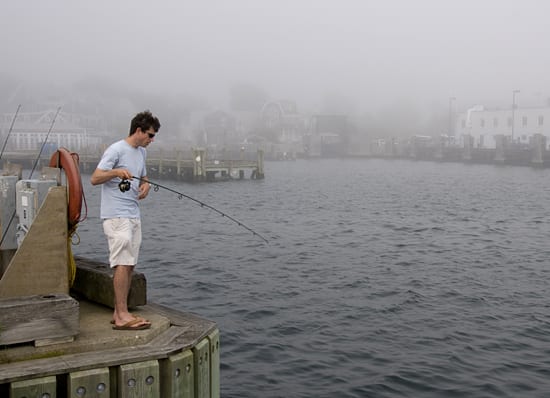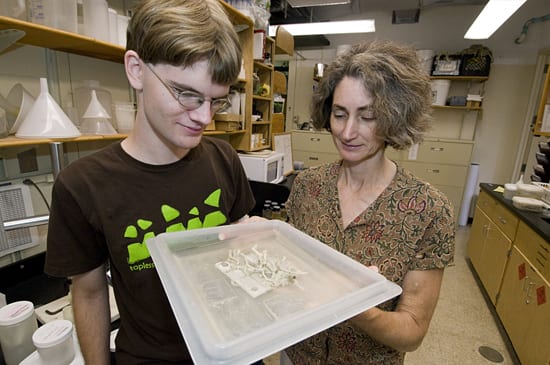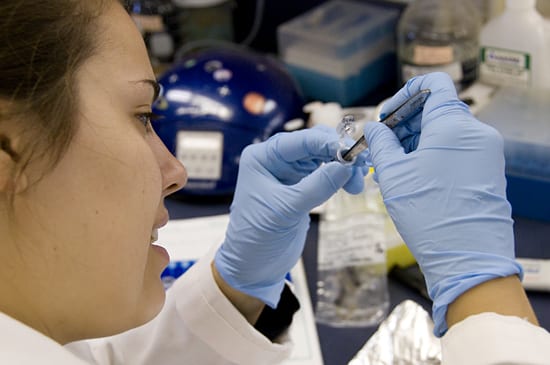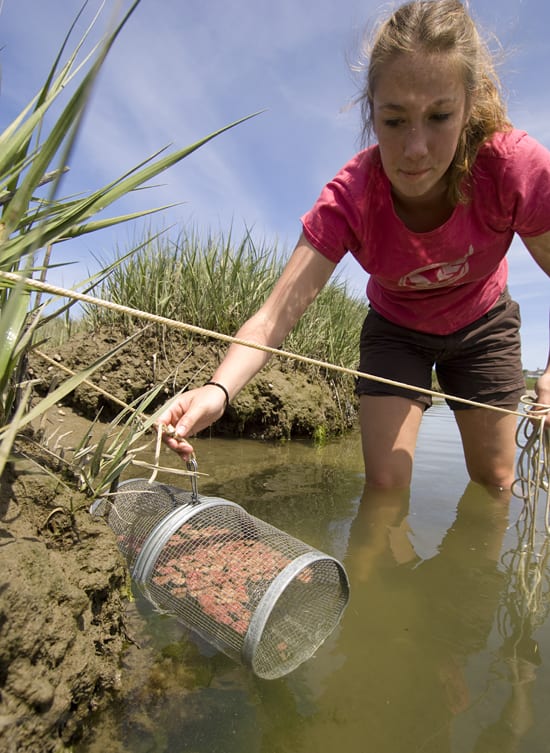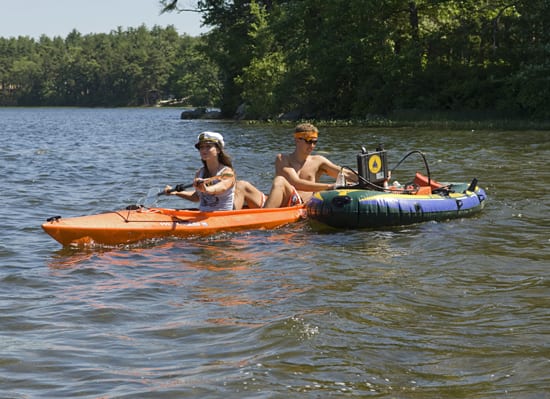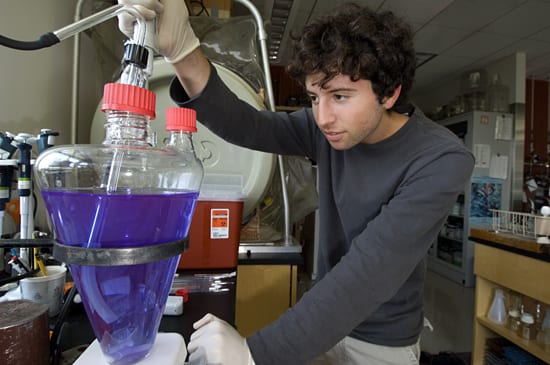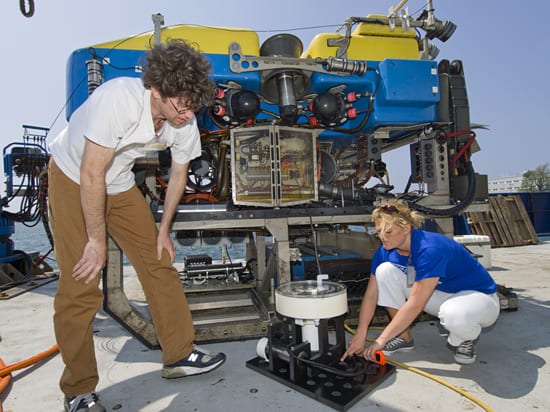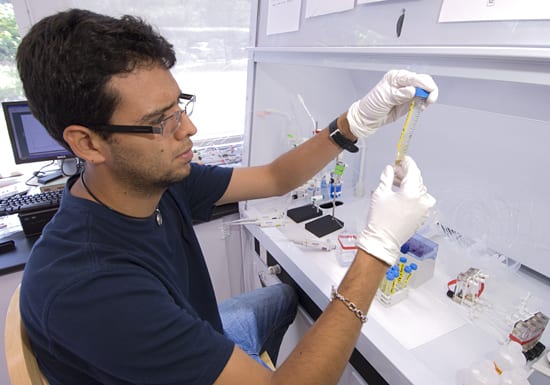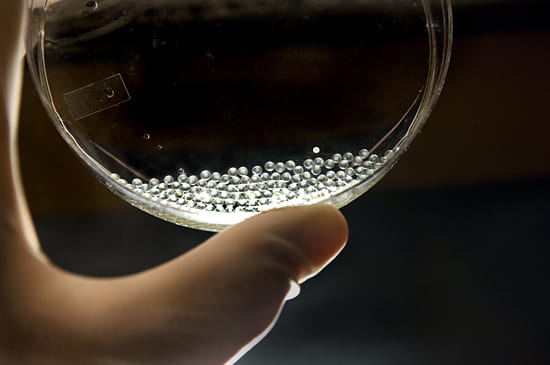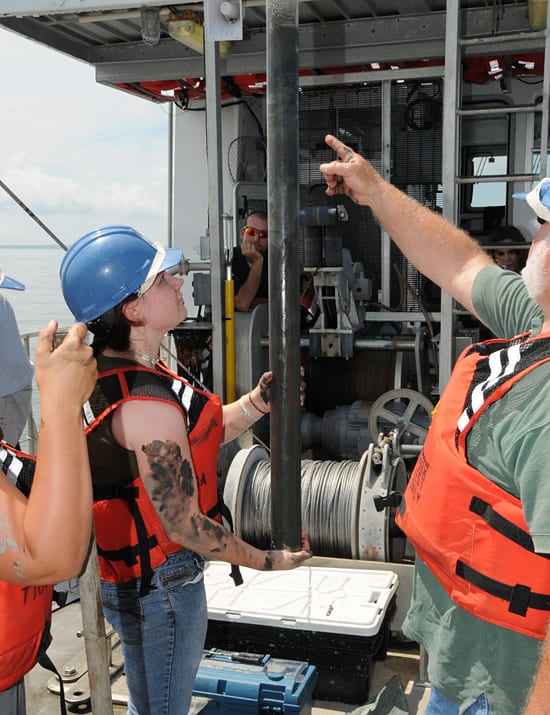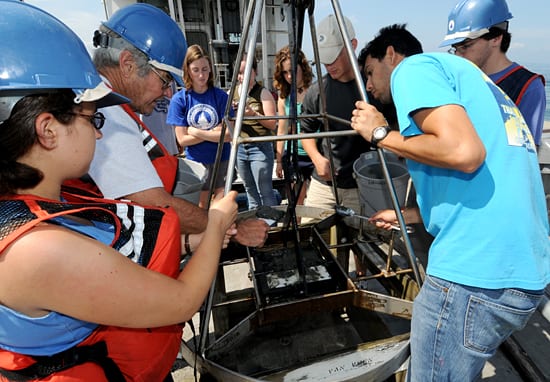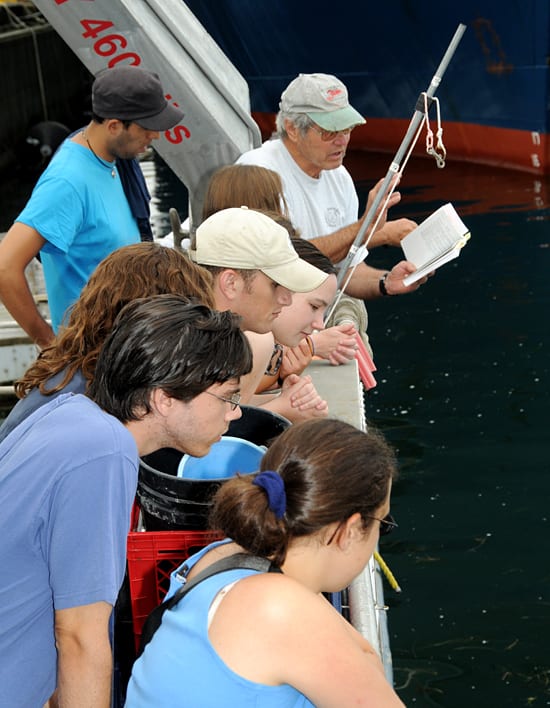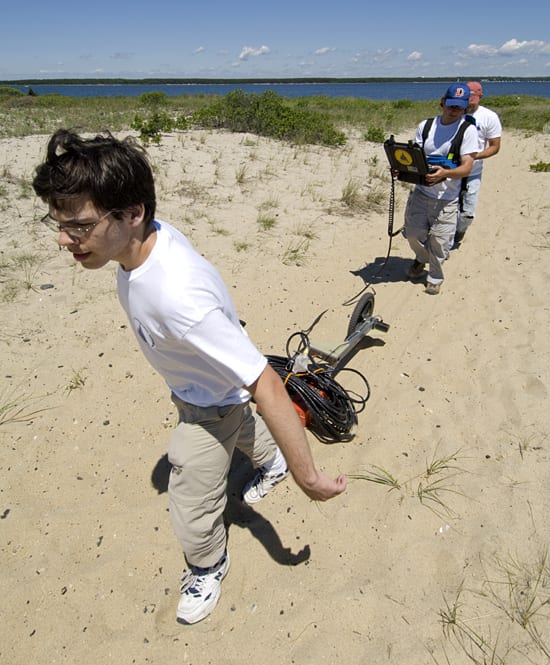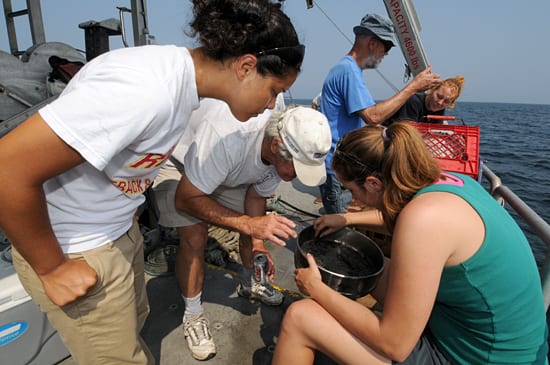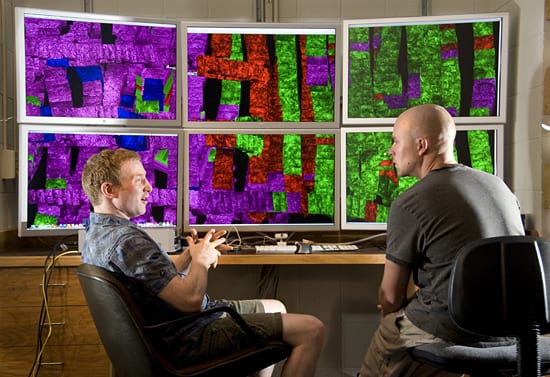Summer Student Fellow William Goldsmith fishes for research off the Iselin dock this past summer. Goldsmith, of Harvard University, worked in WHOI’s Fish Ecology Lab alongside biologist Simon Thorrold. The summer program gives undergraduate students an opportunity to get hands-on oceanographic research experience working with world-class scientists and engineers.
- Summer Student Fellow (SSF) Gar Secrist (left), an ecological biologist, examines tubeworms or Tevnia jerichonana alongside WHOI biologist Lauren Mullineaux, who was also an SSF as an undergraduate. Her laboratory collected many biological samples from P-Vent on the East Pacific Rise, and Secrist’s task was to study and count the variety of creatures through a microscope. With this data, they hoped to gain a better understanding about the recolonization of hydrothermal vent populations after volcanic eruptions.
(Photo by Tom Kleindinst, Woods Hole Oceanographic Institution) - While her Oberlin classmates accepted their diplomas at a graduation ceremony in Ohio, Summer Student Fellow Eleanor Bors was aboard the R/V Kilo Moana along with her advisor, WHOI biologist Tim Shank. The voyage marked the first deployment of the robotic vehicle Nereus, which successfully dove to Challenger Deep —the deepest part of the ocean— on May 31, 2009. Back in Woods Hole, Bors worked on genetic methods for larval identification as part of a study of how worm communities recolonize after hydrothermal vent eruptions. Read more about her experience as a fellow in the blog, "In an Octopus's Garden." (Photo by Tom Kleindinst, Woods Hole Oceanographic Institution
- Summer Student Fellow Abigail LaBella —shown here collecting fish samples from Scorton Creek in Sandwich, MA — spent her summer studying the genetic interaction between hypoxia (low oxygen) and endocrine disruptors alongside biologist Ann Tarrant. The fellowship program gives college juniors and seniors an opportunity to get hands-on oceanographic research experience. (Photo by Tom Kleindinst, Woods Hole Oceanographic Institution)
- Students Nicole Trenhom (in cap) and Zion Klos used ground-penetrating radar this summer in a Cape Cod kettle pond to look for signs of former shorelines deposited during ancient droughts. They worked with WHOI geologist Jeff Donnelly, who studies these types of "natural archives" to reconstruct past environmental conditions. (Photo by Tom Kleindinst, Woods Hole Oceanographic Institution)
- Undergraduate student Tobin Hammer prepares a colorful nutrient solution for culturing micro-organisms in WHOI microbiologist Stefan Sievert's microbial ecology laboratory. Hammer, a 2008 Summer Student Fellow from the University of California, San Diego, worked on assessing the diversity of bacteria in deep-sea sediments from hydrothermal vents in Guaymas Basin in the Gulf of California, Mexico. His project involved aspects of microbial ecology, cultivating anaerobic (without oxygen) bacteria, and molecular techniques, and he found a high diversity of bacteria in the Guaymas sediments. (Photo by Tom Kleindinst, Woods Hole Oceanographic Institution)
- While on board R/V Roger Revelle at the WHOI dock in July 2008, Summer Student Fellow Kaitlyn McCartney (MIT) adjusted a sampler designed by WHOI Post-doctoral Scholar Chip Breier (left, Applied Ocean Physics and Engineering Department.) The new "SUPR" sampler (Suspended Particulate Rosette) collects particles within intensely hot, high-pressure fluid plumes rising from hydrothermal vents—part of efforts to analyze deep-sea compounds in place. McCartney, sponsored by engineer Sheri White, designed the frame to mount SUPR on the ROV Jason (background), and participated in a cruise to collect particles from mid-Atlantic black smoker vents. (Photo by Tom Kleindinst, Woods Hole Oceanographic Institution)
- Jorge Barbosa, an undergraduate at the State University of New York School of Environmental Science and Forestry, spent summer 2008 as a WHOI Summer Student Fellow. Working in the laboratory of Carl Lamborg, he analyzed the mercury levels of animals that live near hydrothermal vents—the first time such measurements have been made. Mercury in the ocean is passed up the food chain as the toxic compound methylmercury, becoming concentrated in top predators such as tuna and swordfish. (Photo by Tom Kleindinst, Woods Hole Oceanographic Institution)
- Summer student Lauren Watka from the University of Massachusetts, Dartmouth holds a petri dish of fish eggs from mummichogs, Fundulus heteroclitus. Working with post-doctoral fellow Matthew Jenny in WHOI biologist John Stegeman's laboratory, she assisted with in vitro fertilization of eggs from fish collected from a reference ("clean") site, and a Superfund site (New Bedford Harbor) contaminated with toxic polychlorinated biphenyls (PCBs). Part of Watka's project was to compare how fish embryos from the two sites developed and expressed genes for proteins called cytochrome P 450s that help detoxify PCBs. (Photo by Tom Kleindinst, Woods Hole Oceanographic Institution)
- Retired WHOI research associate Bruce Tripp (right) explains the fundamentals of how to retrieve a seadiment core, as WHOI summer student fellow Amanda O'Rourke holds their latest catch. Every summer, WHOI staff take the undergraduate group onboard the R/V Tioga for a demonstration of how scientific samples are collected at sea. (Photo by Jayne Doucette, Woods Hole Oceanographic Institution)
- Every year, undergraduates are selected to spend the summer doing research at WHOI, in the Summer Student Fellowship program. Soon after they arrive, the students learn what it's like to go out on a coastal vessel, R/V Tioga, and perform several kinds of standard oceanographic sampling. In July 2008, Oceanographer Emeritus George Hampson (left, in white t-shirt) showed a group of summer student fellows how to recover samples with a box corer, a device that grabs a scoop of seafloor sediment and brings it up to the surface. (Photo by Jayne Doucette, Woods Hole Oceanographic Institution)
- WHOI oceanographer emeritus George Hampson (white t-shirt, in the background) shows undergraduate students in the WHOI Summer Student Fellowship Program how to identify local jellyfish species, as they peer over the side of WHOI's coastal vessel R/V Tioga. Every summer, Hampson takes the year's group of summer students for a day trip to experience basic oceanographic sampling techniques. (Photo by Jayne Doucette, Woods Hole Oceanographic Institution)
- Undergraduate Andrew Delman (Yale University), scientist Andrew Ashton (blue cap, WHOI Geology and Geophysics Department) and Guest Student Nick Magliocca (red cap, Duke University) trek through the sand in the Waquoit Bay National Estuarine Research Reserve on Cape Cod, Mass. in July, 2008. Using Ground-Penetrating Radar (GPR) they searched for below-the-surface deposits left by past storms, to investigate how barrier beaches respond to changes in storminess and sea level. As a WHOI Summer Student Fellow, Delman spent the summer collecting and analyzing data and developing a model of long-term barrier-beach evolution. (Photo by Tom Kleindinst, Woods Hole Oceanographic Institution)
- Oceanographer Emeritus and biologist George Hampson (center) and Hovey Clifford (blue shirt) retired WHOI dockmaster and present CPR teacher and EMT showing Summer Student Fellows Yadira Ibarra (left) and Abigail Labella (right) how to collect tiny animal samples from a sieve. After collecting the samples they will further inspect the samples under a microscope in the lab on R/V Tioga. (Photo by Jayne Doucette, Woods Hole Oceanographic Institution)
Summer Student Fellow Garrett Mitchell, of the University of Maryland at College Park, spent his summer working with WHOI geologist Adam Soule. The two used seafloor imagery collected by Autonomous Benthic Explorer (ABE) to map lava flows, hydrothermal vents, and biologic communities on the Southern Mid-Atlantic Ridge (5˚S). The image behind them is a mosaic, where each of the several thousand seafloor photographs is pieced together like a puzzle based on the location and attitude (pitch, roll, yaw) of the vehicle.
Image and Visual Licensing
WHOI copyright digital assets (stills and video) contained on this website can be licensed for non-commercial use upon request and approval. Please contact WHOI Digital Assets at images@whoi.edu or (508) 289-2647.
